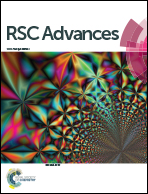Pickering emulsions stabilized by composite nanoparticles prepared from lysozyme and dopamine modified poly (γ-glutamic acid): effects of pH value on the stability of the emulsion and the activity of lysozyme
Abstract
Novel bio-based composite nanoparticles were prepared through the electrostatic interaction between lysozyme (Lys) and amphiphilic dopamine-modified poly (γ-glutamic acid) (PGA-DA). The composite nanoparticles were used as particulate emulsifiers to stabilize white oil, forming gel-like emulsions. When the concentration of PGA-DA and Lys was 0.75 mg mL−1, the mean diameter of the composite nanoparticles was smallest (423 nm) with excellent stability. The influences of pH values on the properties of the composite nanoparticles, emulsifying performances and the activity of Lys in the emulsions were carefully investigated. Scanning electron microscopy (SEM) and laser scanning confocal microscopy (CLSM) characterization demonstrated that the composite nanoparticles adsorbed at the oil–water interface. Rheological measurements provided a possible stabilizing mechanism, which depended on the network structure of the adsorption layer at the interface-phase. Emulsifying properties were significantly improved with increasing the pH value of the solution. In addition, the bioactivity of emulsions at pH 6.2 was highest and well retained during a storage period of three months.


 Please wait while we load your content...
Please wait while we load your content...